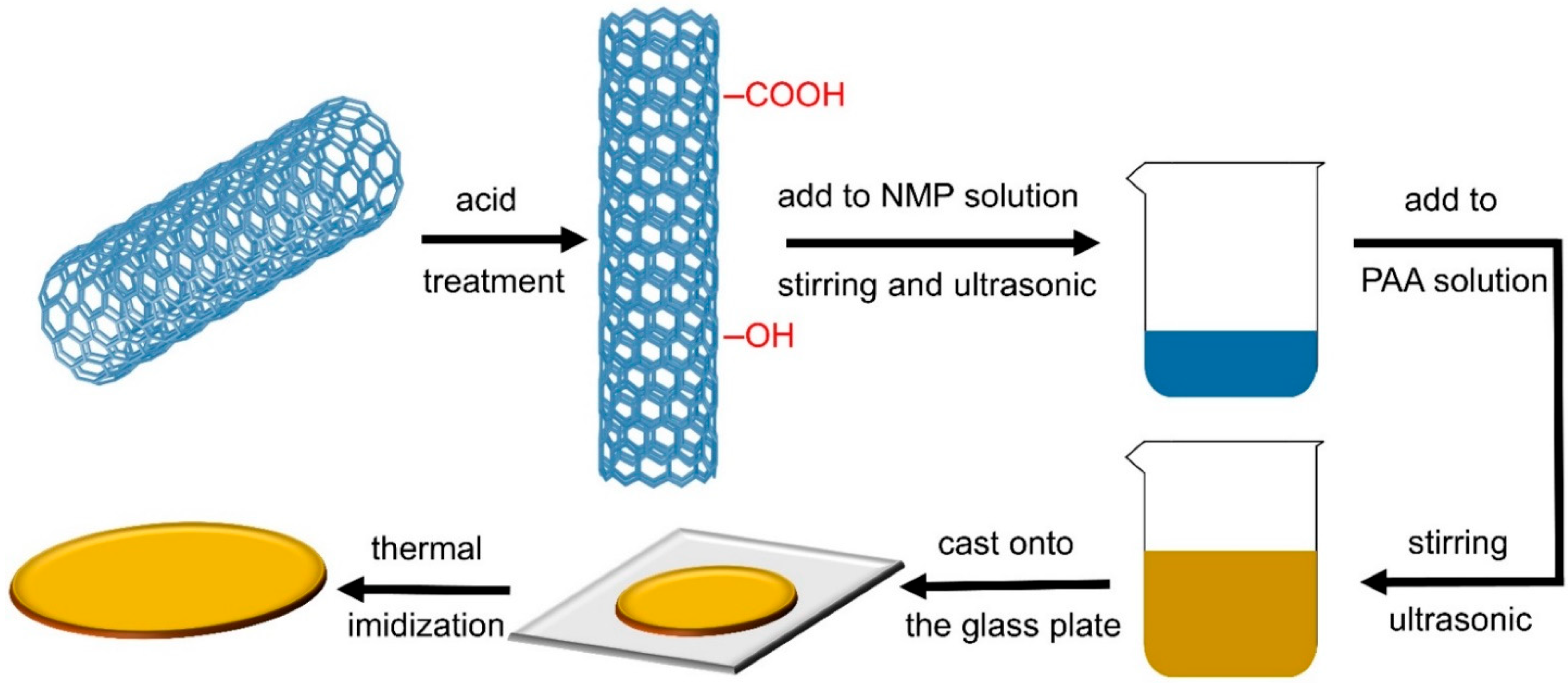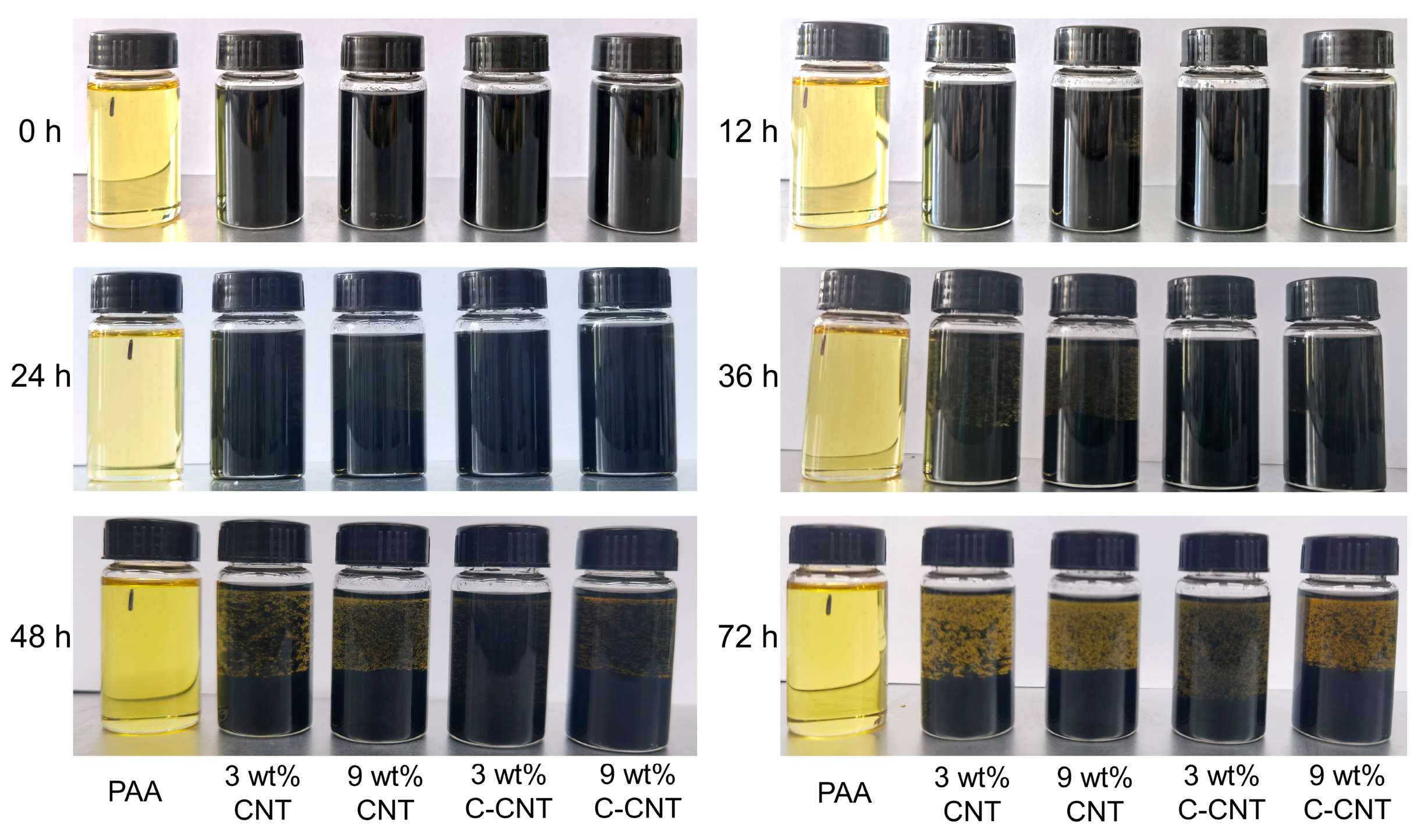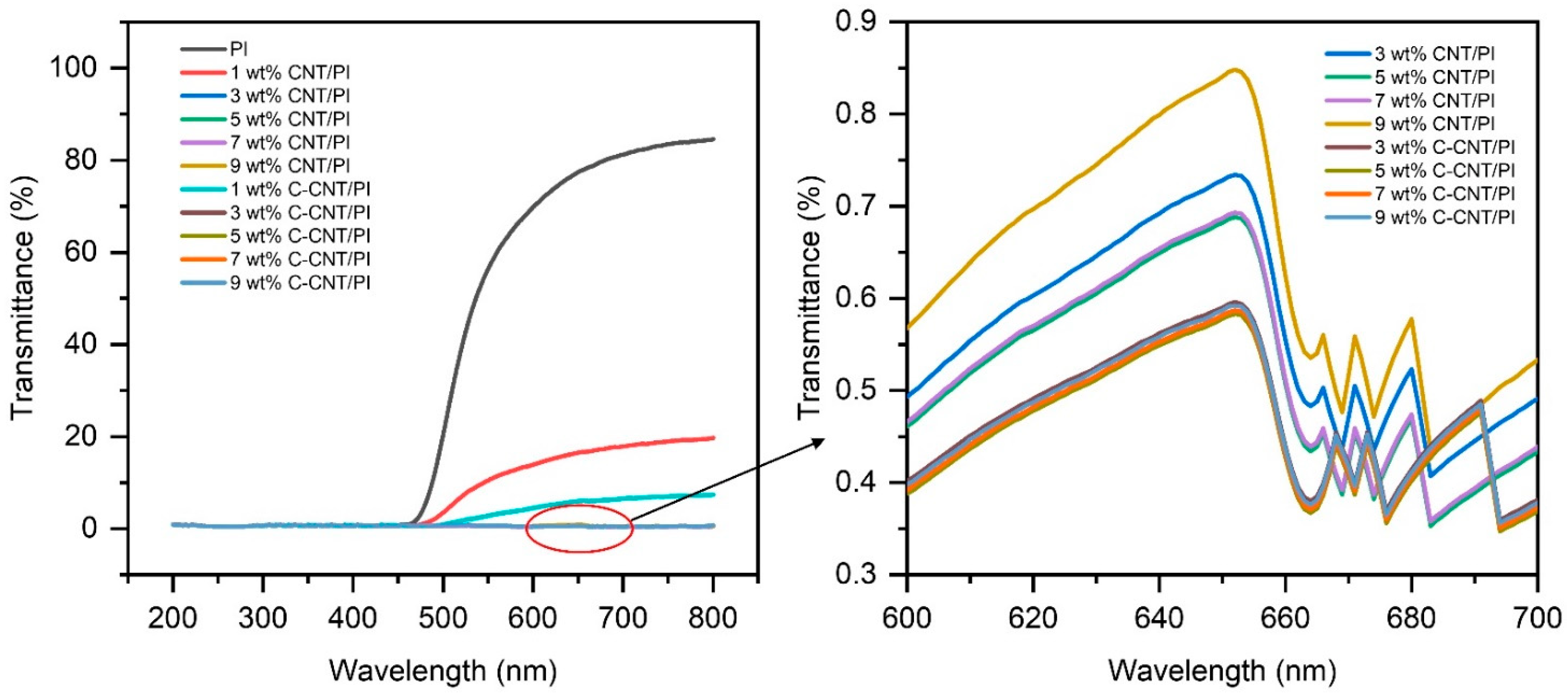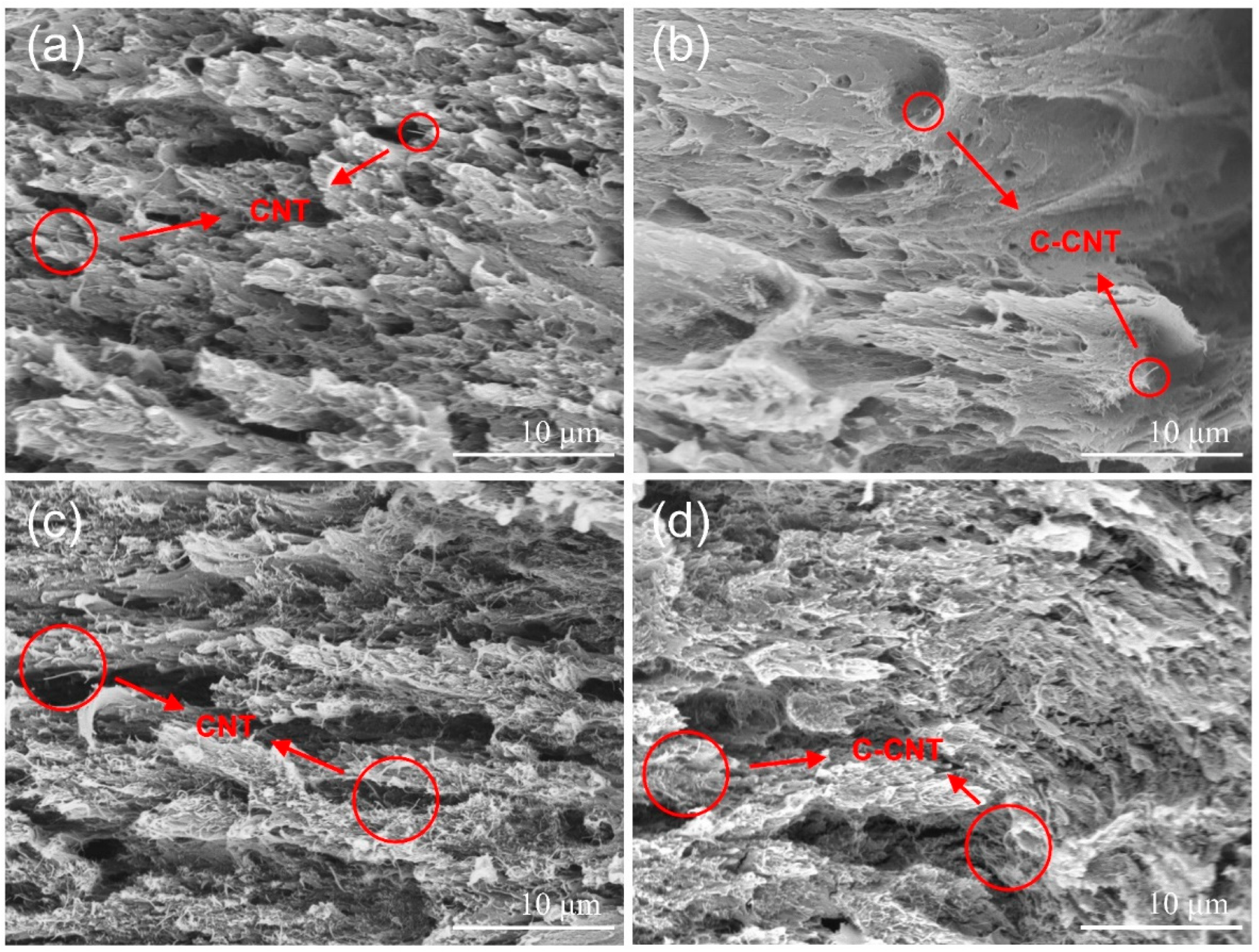Carboxylated Carbon Nanotube/Polyimide Films with Low Thermal Expansion Coefficient and Excellent Mechanical Properties
Abstract
:1. Introduction
2. Materials and Method
2.1. Materials
2.2. Preparation of C-CNT
2.3. Preparation of CNT/PI and C-CNT/PI Films
2.4. Characterizations
3. Results and Discussion
3.1. Chemical Composition of CNT and C-CNT
3.2. Morphology and Dispersion of CNT and C-CNT in Solution and Film
3.3. Thermal Properties of CNT/PI and C-CNT/PI Films
3.4. Mechanical Properties of CNT/PI and C-CNT/PI Films
4. Conclusions
Supplementary Materials
Author Contributions
Funding
Institutional Review Board Statement
Informed Consent Statement
Data Availability Statement
Acknowledgments
Conflicts of Interest
References
- Wang, K.; Amin, K.; An, Z.; Cai, Z.; Chen, H.; Chen, H.; Dong, Y.; Feng, X.; Fu, W.; Gu, J.; et al. Advanced functional polymer materials. Mater. Chem. Front. 2020, 4, 1803–1915. [Google Scholar] [CrossRef]
- Ou, X.; Lu, X.; Chen, S.; Lu, Q. Thermal conductive hybrid polyimide with ultrahigh heat resistance, excellent mechanical properties and low coefficient of thermal expansion. Eur. Polym. J. 2020, 122, 109368. [Google Scholar] [CrossRef]
- Ji, S.; Yang, J.; Zhao, J.; Hu, Y.; Gao, H. Study about mechanical property and machinability of polyimide. Polymers 2018, 10, 173. [Google Scholar] [CrossRef] [PubMed] [Green Version]
- Ruan, H.; Zhang, Q.; Liao, W.; Li, Y.; Huang, X.; Xu, X.; Lu, S. Enhancing tribological, mechanical, and thermal properties of polyimide composites by the synergistic effect between graphene and ionic liquid. Mater. Des. 2020, 189, 108527. [Google Scholar] [CrossRef]
- Wang, B.; He, B.; Wang, Z.; Qi, S.; Zhang, D.; Tian, G.; Wu, D. Enhanced impact properties of hybrid composites reinforced by carbon fiber and polyimide fiber. Polymers 2021, 13, 2599. [Google Scholar] [CrossRef]
- Chang, J.; Ge, Q.; Zhang, M.; Liu, W.; Cao, L.; Niu, H.; Sui, G.; Wu, D. Effect of pre-imidization on the structures and properties of polyimide fibers. RSC Adv. 2015, 5, 69555–69566. [Google Scholar] [CrossRef]
- Zhang, M.; Niu, H.; Chang, J.; Ge, Q.; Cao, L.; Wu, D. High-performance fibers based on copolyimides containing benzimidazole and ether moieties: Molecular packing, morphology, hydrogen-bonding interactions and properties. Polym. Eng. Sci. 2015, 55, 2615–2625. [Google Scholar] [CrossRef]
- Wang, Z.; Zhang, J.; Niu, H.; Wu, D.; Zhang, M.; Han, E.; Sheng, J.; Sun, X.; Fan, C. Influences of different imidization conditions on polyimide fiber properties and structure. J. Appl. Polym. Sci. 2021, 138, 51189. [Google Scholar] [CrossRef]
- Wu, B.; Zhang, Y.; Yang, D.; Yang, Y.; Yu, Q.; Che, L.; Liu, J. Self-healing anti-atomic-oxygen phosphorus-containing polyimide film via molecular level incorporation of nanocage trisilanolphenyl POSS: Preparation and characterization. Polymers 2019, 11, 1013. [Google Scholar] [CrossRef] [PubMed] [Green Version]
- Chang, Z.; Sun, X.; Liao, Z.; Liu, Q.; Han, J. Des and preparation of polyimide/TiO2@ MoS2 nanofibers by hydrothermal synthesis and their photocatalytic performance. Polymers 2022, 14, 3230. [Google Scholar] [CrossRef]
- Yan, Y.; Mao, Y.; Li, B.; Zhou, P. Machinability of the thermoplastic polymers: PEEK, PI, and PMMA. Polymers 2020, 13, 69. [Google Scholar] [CrossRef] [PubMed]
- Hornig, A.; Winkler, A.; Bauerfeind, E.; Gude, M.; Modler, N. Delamination behaviour of embedded polymeric sensor and actuator carrier layers in epoxy based CFRP laminates—A study of energy release rates. Polymers 2021, 13, 3926. [Google Scholar] [CrossRef] [PubMed]
- Toshiyuki, T.; Maeda, S.; Tsukada, Y. Packaging substrate applications of ultralow CTE polyimide. J. Photopolym. Sci. Technol. 2012, 25, 359–364. [Google Scholar]
- Tian, Y.; Luo, L.; Yang, Q.; Zhang, L.; Wang, M.; Wu, D.; Wang, X.; Liu, X. Construction of stable hydrogen bonds at high temperature for preparation of polyimide films with ultralow coefficient of thermal expansion and high Tg. Polymer 2020, 188, 122100. [Google Scholar] [CrossRef]
- Zhuang, Y.; Seong, J.G.; Lee, Y.M. Polyimides containing aliphatic/alicyclic segments in the main chains. Prog. Polym. Sci. 2019, 92, 35–88. [Google Scholar] [CrossRef]
- Huang, Y.; Shen, X.; Wang, Z.; Jin, K.; Lu, J.Q.; Wang, C. Zero thermal expansion polyarylamide film with reversible conformational change structure. Macromolecules 2018, 51, 8477–8485. [Google Scholar] [CrossRef]
- Choi, J.Y.; Jin, S.W.; Kim, D.M.; Song, I.H.; Nam, K.N.; Park, H.J.; Chung, C.M. Enhancement of the mechanical properties of polyimide film by microwave irradiation. Polymers 2019, 11, 477. [Google Scholar] [CrossRef] [Green Version]
- Iijima, S. Helical microtubules of graphitic carbon. Nature 1991, 354, 56–58. [Google Scholar] [CrossRef]
- Sholl, D.S.; Johnson, J.K. Making high-flux films with carbon nanotubes. Mater. Sci. 2006, 312, 1003–1004. [Google Scholar]
- Ma, P.C.; Kim, J.-K.; Tang, B.Z. Functionalization of carbon nanotubes using a silane coupling agent. Carbon 2006, 44, 3232–3238. [Google Scholar] [CrossRef] [Green Version]
- Xu, H.; Schubert, D.W. Electrical conductivity of polystyrene/poly (n-alkyl methacrylate) s/carbon nanotube ternary composite casting films. J. Polym. Res. 2020, 27, 153. [Google Scholar] [CrossRef]
- Gissinger, J.R.; Pramanik, C.; Newcomb, B.; Kumar, S.; Heinz, H. Nanoscale structure-property relationships of polyacrylonitrile/CNT composites as a function of polymer crystallinity and CNT diameter. ACS Appl. Mater. Inter. 2018, 10, 1017–1027. [Google Scholar] [CrossRef] [PubMed]
- Qin, S.; Cui, M.; Dai, Z.; Qiu, S.; Zhao, H.; Wang, L.; Zhang, A. Noncovalent functionalized graphene-filled polyimides with improved thermal, mechanical, and wear resistance properties. Tribol. Lett. 2018, 66, 69. [Google Scholar] [CrossRef]
- Song, K.; Zhang, Y.; Meng, J.; Green, E.C.; Tajaddod, N.; Li, H.; Minus, M.L. Structural polymer-based carbon nanotube composite fibers: Understanding the processing-structure-performance relationship. Materials 2013, 6, 2543–2577. [Google Scholar] [CrossRef] [Green Version]
- Li, H.; Minus, M.L. On the formation of potential polymer-nanotube blends by liquid-solid phase separation. Polymer 2017, 131, 179–192. [Google Scholar] [CrossRef]
- Coleman, J.N.; Khan, U.; Blau, W.J.; Gun’ko, Y.K. Small but strong: A review of the mechanical properties of carbon nanotube–polymer composites. Carbon 2006, 44, 1624–1652. [Google Scholar] [CrossRef]
- Kim, C.; Yang, K. Electrochemical properties of carbon nanofiber web as an electrode for supercapacitor prepared by electrospinning. Appl. Phys. Lett. 2003, 83, 1216–1218. [Google Scholar] [CrossRef]
- Dalton, A.B.; Collins, S.; Munoz, E.; Razal, J.M.; Ebron, V.H.; Ferraris, J.P.; Coleman, J.N.; Kim, B.G.; Baughman, R.H. Super-tough carbon-nanotube fibres. Nature 2003, 423, 703. [Google Scholar] [CrossRef]
- Tanaike, O.; Hatori, H.; Yamada, Y.; Shiraishi, S.; Oya, A. Preparation and pore control of highly mesoporous carbon from defluorinated PTFE. Carbon 2003, 41, 1759–1764. [Google Scholar] [CrossRef]
- Park, J.H.; Ko, J.M.; Park, O.O.; Kim, D.-W. Capacitance properties of graphite/polypyrrole composite electrode prepared by chemical polymerization of pyrrole on graphite fiber. J. Power Source 2002, 105, 20–25. [Google Scholar] [CrossRef]
- Raunika, A.; Raj, S.A.; Jayakrishna, K.; Sultan, M. In carbon nanotube: A review on its mechanical properties and application in aerospace industry. IOP Conf. Ser. Mater. Sci. Eng. 2016, 270, 012027. [Google Scholar] [CrossRef] [Green Version]
- Jin, S.; Son, G.; Kim, Y.; Kim, C.-G. Enhanced durability of silanized multi-walled carbon nanotube/epoxy nanocomposites under simulated low earth orbit space environment. Compos. Sci. Technol. 2013, 87, 224–231. [Google Scholar] [CrossRef]
- Ahmed, K.; Khosla, A.; Kawakami, M.; Furukawa, H. Poly ionic liquid-based nano composites for smart electro-mechanical devices. SPIE 2017, 10167, 97–103. [Google Scholar]
- Ju, Y.-W.; Choi, G.-R.; Jung, H.-R.; Lee, W.-J. Electrochemical properties of electrospun PAN/MWCNT carbon nanofibers electrodes coated with polypyrrole. Electrochim. Acta 2008, 53, 5796–5803. [Google Scholar] [CrossRef]
- Jiang, M.; Lin, D.; Jia, W.; Du, J.; Han, E.; Zhang, M.; Niu, H.; Wu, D. Preparation and properties of polyimide/carbon nanotube composite films with electromagnetic wave absorption performance. Polym. Eng. Sci. 2021, 61, 2691–2700. [Google Scholar] [CrossRef]
- Monthioux, M.; Smith, B.W.; Burteaux, B.; Claye, A.; Fischer, J.E.; Luzzi, D.E. Sensitivity of single-wall carbon nanotubes to chemicalprocessing: An electron microscopy investigation. Carbon 2001, 39, 1251–1272. [Google Scholar] [CrossRef]
- Rafiee, R.; Ghorbanhosseini, A. Investigating interaction between CNT and polymer using cohesive zone model. Polym. Compos. 2018, 39, 3903–3911. [Google Scholar] [CrossRef]
- Kosynkin, D.V.; Higginbotham, A.L.; Sinitskii, A.; Lomeda, J.R.; Dimiev, A.; Price, B.K.; Tour, J.M. Longitudinal unzipping of carbon nanotubes to form graphene nanoribbons. Nature 2009, 458, 872–876. [Google Scholar] [CrossRef] [Green Version]
- Lutsyk, P.M.; Shankar, P.; Rozhin, A.G.; Kulinich, S.A. Surface sensitivity of ultrasonically treated carbon nanotube network towards ammonia. Surf. Interfaces 2019, 17, 100363. [Google Scholar] [CrossRef]
- Al Araimi, M.; Lutsyk, P.; Verbitsky, A.; Piryatinski, Y.; Shandura, M.; Rozhin, A. A dioxaborine cyanine dye as a photoluminescence probe for sensing carbon nanotubes. Beilstein. J. Nanotechnol. 2016, 7, 1991–1999. [Google Scholar] [CrossRef] [Green Version]
- Lutsyk, P.; Piryatinski, Y.; AlAraimi, M.; Arif, R.; Shandura, M.; Kachkovsky, O.; Verbitsky, A.; Rozhin, A. Emergence of additional visible-range photoluminescence due to aggregation of cyanine dye: Astraphloxin on carbon nanotubes dispersed with anionic surfactant. J. Phys. Chem. C 2016, 120, 20378–20386. [Google Scholar] [CrossRef] [Green Version]
- Lutsyk, P.; Piryatinski, Y.; Shandura, M.; AlAraimi, M.; Tesa, M.; Arnaoutakis, G.E.; Melvin, A.A.; Kachkovsky, O.; Verbitsky, A.; Rozhin, A. Self-Assembly for Two Types of J-Aggregates: Cis-Isomers of Dye on the Carbon Nanotube Surface and Free Aggregates of Dye trans-Isomers. J. Phys. Chem. C 2019, 123, 19903–19911. [Google Scholar] [CrossRef]
- Park, S.K.; Kim, S.H.; Hwang, J.T. Carboxylated multiwall carbon nanotube-reinforced thermotropic liquid crystalline polymer nanocomposites. J. Appl. Polym. Sci. 2008, 109, 388–396. [Google Scholar] [CrossRef]
- Wu, H.-L.; Ma, C.-C.M.; Yang, Y.-T.; Kuan, H.-C.; Yang, C.-C.; Chiang, C.-L. Morphology, electrical resistance, electromagnetic interference shielding and mechanical properties of functionalized MWNT and poly (urea urethane) nanocomposites. J. Polym. Sci. Pol. Phys. 2006, 44, 1096–1105. [Google Scholar] [CrossRef]
- Vast, L.; Philippin, G.; Destrée, A.; Moreau, N.; Fonseca, A.; Nagy, J.B.; Delhalle, J.; Mekhalif, Z. Chemical functionalization by a fluorinated trichlorosilane of multi-walled carbon nanotubes. Nanotechnology 2004, 15, 781–785. [Google Scholar] [CrossRef]
- Sun, H.; Wang, T.; Xu, Y.; Gao, W.; Li, P.; Niu, Q.J. Fabrication of polyimide and functionalized multi-walled carbon nanotubes mixed matrix films by in-situ polymerization for CO2 separation. Sep. Purif. Technol. 2017, 177, 327–336. [Google Scholar] [CrossRef]
- Zhang, Q.; Li, S.; Wang, C.; Chang, H.-C.; Guo, R. Carbon nanotube-based mixed-matrix films with supramolecularly engineered interface for enhanced gas separation performance. J. Film. Sci. 2020, 598, 117794. [Google Scholar]
- Lee, J.-H.; Rhee, K.Y.; Park, S.J. Silane modification of carbon nanotubes and its effects on the material properties of carbon/CNT/epoxy three-phase composites. Compos. Part A Appl. Sci. Manuf. 2011, 42, 478–483. [Google Scholar] [CrossRef]
- Mathkar, A.; Aichele, C.; Omole, I.; Singh, N.; Hashim, D.; Gullapalli, H.; Ajayan, P.M. Creating supersolvophobic nanocomposite materials. RSC Adv. 2013, 3, 4216–4220. [Google Scholar] [CrossRef]
- Zhang, X.; Zhang, W.; Dai, J.; Sun, M.; Zhao, J.; Ji, L.; Chen, L.; Zeng, F.; Yang, F.; Huang, B. Carboxylated carbon nanotubes with high electrocatalytic activity for oxygen evolution in acidic conditions. InfoMat 2022, 4, 12273. [Google Scholar] [CrossRef]
- Aroon, M.A.; Ismail, A.F.; Montazer-Rahmati, M.M.; Matsuura, T. Effect of chitosan as a functionalization agent on the performance and separation properties of polyimide/multi-walled carbon nanotubes mixed matrix flat sheet films. J. Membr. Sci. 2010, 364, 309–317. [Google Scholar] [CrossRef]
- Holzinger, M.; Abraham, J.; Whelan, P.; Graupner, R.; Ley, L.; Hennrich, F.; Kappes, M.; Hirsch, A. Functionalization of single-walled carbon nanotubes with (R-) oxycarbonyl nitrenes. J. Am. Chem. Soc. 2003, 125, 8566–8580. [Google Scholar] [CrossRef] [PubMed]
- Kim, S.; Lee, Y.-I.; Kim, D.-H.; Lee, K.-J.; Kim, B.-S.; Hussain, M.; Choa, Y.-H. Estimation of dispersion stability of UV/ozone treated multi-walled carbon nanotubes and their electrical properties. Carbon 2013, 51, 346–354. [Google Scholar] [CrossRef]
- Yuan, W.; Che, J.; Chan-Park, M.B. A novel polyimide dispersing matrix for highly electrically conductive solution-cast carbon nanotube-based composite. Chem. Mater. 2011, 23, 4149–4157. [Google Scholar] [CrossRef]
- Stephen, F.; Dinetz, E.J.B.; Raymond, L.; Wagner, A.W. Fountain III. A comparative study of the gaseous productsgenerated by thermal and ultra-violet laserpyrolyses of the polyimide PMDA-ODA. J. Anal. Appl. Pyrol. 2002, 63, 241–249. [Google Scholar]
- Weng, T.-H.; Tseng, H.-H.; Wey, M.-Y. Preparation and characterization of multi-walled carbon nanotube/PBNPI nanocomposite film for H2/CH4 separation. Int. J. Hydrog. Energy 2009, 34, 8707–8715. [Google Scholar] [CrossRef]
- Tan, J.; Huang, J.; Liu, Y.; Ding, Q.; Zeng, Y.; Zhang, H.; Liu, Y.; Xiang, X. Novel high-barrier polyimide containing rigid planar dibenzofuran moiety in main chain. High Perform. Polym. 2017, 30, 539–548. [Google Scholar] [CrossRef]
- Hassanzadeh-Aghdam, M.K.; Mahmoodi, M.J.; Ansari, R.; Mehdipour, H. Effects of adding CNTs on the thermo-mechanical characteristics of hybrid titanium nanocomposites. Mech. Mater. 2019, 131, 121–135. [Google Scholar] [CrossRef]
- Pan, J.; Bian, L.C. Coefficients of Thermal Expansion for Composites with Agglomerated Carbon Nanotubes. IOP Conf. Ser. Mater. Sci. Eng. 2017, 281, 012043. [Google Scholar] [CrossRef]
- Hamester, M.R.R.; Pietezak, D.F.; Dalmolin, C.; Becker, D. Influence of crystallinity and chain interactions on the electrical properties of polyamides/carbon nanotubes nanocomposites. J. Appl. Polym. Sci. 2021, 138, 50817. [Google Scholar] [CrossRef]
- Ishii, J.; Takata, A.; Oami, Y.; Yokota, R.; Vladimirov, L.; Hasegawa, M. Spontaneous molecular orientation of polyimides induced by thermal imidization (6). Mechanism of negative in-plane CTE generation in non-stretched polyimide films. Eur. Polym. J. 2010, 46, 681–693. [Google Scholar] [CrossRef]
- Pottiger, M.T.; Coburn, J.C.; Edman, J.R. The Effect of Orientation on Thermal Expansion Behavior in Polyimide Films. J. Polym. Sci. B Polym. Phys. 1994, 32, 825–837. [Google Scholar] [CrossRef]
- Bakshi, S.R.; Agarwal, A. An analysis of the factors affecting strengthening in carbon nanotube reinforced aluminum composites. Carbon 2011, 49, 533–544. [Google Scholar] [CrossRef]
- Deng, C.F.; Wang, D.Z.; Zhang, X.X.; Li, A.B. Processing and properties of carbon nanotubes reinforced aluminum composites. Mater. Sci. Eng. A 2007, 444, 138–145. [Google Scholar] [CrossRef]












| Samples | Contents of the Functional Groups | |||
|---|---|---|---|---|
| Sp2 C (%) | Sp3 C (%) | –C–O– (%) | –CO–O– (%) | |
| CNT | 65.93 | 15.70 | 7.04 | 11.33 |
| C-CNT | 40.46 | 31.92 | 11.74 | 15.88 |
| Samples | Element Content (%) | Proportion | |||
|---|---|---|---|---|---|
| C | O | N | S | O/C | |
| CNT | 97.30 | 1.27 | 1.28 | 0.15 | 0.01 |
| C-CNT | 95.20 | 3.79 | 0.85 | 0.15 | 0.04 |
| Samples | Contact Angle (°) | Samples | Contact Angle (°) |
|---|---|---|---|
| PI | 55.74 ± 2.31 | - | - |
| 1 wt.% CNT/PI | 62.87 ± 1.53 | 1 wt.% C-CNT/PI | 58.23 ± 1.97 |
| 3 wt.% CNT/PI | 72.90 ± 0.21 | 3 wt.% C-CNT/PI | 69.72 ± 0.74 |
| 5 wt.% CNT/PI | 74.09 ± 0.32 | 5 wt.% C-CNT/PI | 70.19 ± 1.52 |
| 7 wt.% CNT/PI | 74.69 ± 0.62 | 7 wt.% C-CNT/PI | 72.79 ± 0.81 |
| 9 wt.% CNT/PI | 81.17 ± 0.91 | 9 wt.% C-CNT/PI | 76.23 ± 1.65 |
| Samples | T650 (‰) | Samples | T650 (‰) |
|---|---|---|---|
| PI | 774.18 | - | - |
| 1 wt.% CNT/PI | 164.98 | 1 wt.% C-CNT/PI | 59.45 |
| 3 wt.% CNT/PI | 7.28 | 3 wt.% C-CNT/PI | 5.90 |
| 5 wt.% CNT/PI | 6.82 | 5 wt.% C-CNT/PI | 5.81 |
| 7 wt.% CNT/PI | 6.83 | 7 wt.% C-CNT/PI | 5.81 |
| 9 wt.% CNT/PI | 8.41 | 9 wt.% C-CNT/PI | 5.82 |
| Samples | 5 wt.% Loss Temperature (°C) | 800 °C Residual Rate (%) |
|---|---|---|
| PI | 551.63 | 49.93 |
| 1 wt.% CNT/PI | 557.97 | 55.65 |
| 3 wt.% CNT/PI | 576.47 | 58.07 |
| 5 wt.% CNT/PI | 585.93 | 58.61 |
| 7 wt.% CNT/PI | 587.85 | 58.72 |
| 9 wt.% CNT/PI | 578.11 | 59.43 |
| 1 wt.% C-CNT/PI | 581.88 | 57.64 |
| 3 wt.% C-CNT/PI | 590.05 | 57.99 |
| 5 wt.% C-CNT/PI | 590.09 | 58.79 |
| 7 wt.% C-CNT/PI | 595.49 | 58.93 |
| 9 wt.% C-CNT/PI | 586.07 | 59.61 |
| Samples | CTE (ppm/K) | Samples | CTE (ppm/K) |
|---|---|---|---|
| PI | 26.51 ± 0.32 | - | - |
| 1 wt.% CNT/PI | 25.59 ± 0.12 | 1 wt.% C-CNT/PI | 23.87 ± 0.62 |
| 3 wt.% CNT/PI | 24.31 ± 0.26 | 3 wt.% C-CNT/PI | 22.38 ± 0.27 |
| 5 wt.% CNT/PI | 22.97 ± 0.41 | 5 wt.% C-CNT/PI | 21.07 ± 0.17 |
| 7 wt.% CNT/PI | 22.26 ± 0.18 | 7 wt.% C-CNT/PI | 20.31 ± 0.27 |
| 9 wt.% CNT/PI | 21.68 ± 0.60 | 9 wt.% C-CNT/PI | 19.30 ± 0.38 |
| Samples | Tensile Strength (MPa) | Tensile Modulus (GPa) |
|---|---|---|
| PI | 78.69 ± 3.87 | 2.31 ± 0.08 |
| 1 wt.% CNT/PI | 79.50 ± 2.27 | 2.39 ± 0.12 |
| 3 wt.% CNT/PI | 91.18 ± 4.61 | 2.65 ± 0.18 |
| 5 wt.% CNT/PI | 95.61 ± 1.42 | 2.64 ± 0.13 |
| 7 wt.% CNT/PI | 90.80 ± 1.92 | 2.63 ± 0.02 |
| 9 wt.% CNT/PI | 85.22 ± 3.72 | 2.56 ± 0.18 |
| 1 wt.% C-CNT/PI | 79.21 ± 5.06 | 2.50 ± 0.07 |
| 3 wt.% C-CNT/PI | 92.10 ± 2.93 | 2.71 ± 0.17 |
| 5 wt.% C-CNT/PI | 97.52 ± 4.33 | 3.02 ± 0.10 |
| 7 wt.% C-CNT/PI | 92.49 ± 3.68 | 2.67 ± 0.10 |
| 9 wt.% C-CNT/PI | 87.50 ± 1.68 | 2.60 ± 0.13 |
Publisher’s Note: MDPI stays neutral with regard to jurisdictional claims in published maps and institutional affiliations. |
© 2022 by the authors. Licensee MDPI, Basel, Switzerland. This article is an open access article distributed under the terms and conditions of the Creative Commons Attribution (CC BY) license (https://creativecommons.org/licenses/by/4.0/).
Share and Cite
Lu, C.; Lin, F.; Shao, H.; Bi, S.; Chen, N.; Shao, G.; Jiang, J. Carboxylated Carbon Nanotube/Polyimide Films with Low Thermal Expansion Coefficient and Excellent Mechanical Properties. Polymers 2022, 14, 4565. https://doi.org/10.3390/polym14214565
Lu C, Lin F, Shao H, Bi S, Chen N, Shao G, Jiang J. Carboxylated Carbon Nanotube/Polyimide Films with Low Thermal Expansion Coefficient and Excellent Mechanical Properties. Polymers. 2022; 14(21):4565. https://doi.org/10.3390/polym14214565
Chicago/Turabian StyleLu, Cheng, Fangbing Lin, Huiqi Shao, Siyi Bi, Nanliang Chen, Guangwei Shao, and Jinhua Jiang. 2022. "Carboxylated Carbon Nanotube/Polyimide Films with Low Thermal Expansion Coefficient and Excellent Mechanical Properties" Polymers 14, no. 21: 4565. https://doi.org/10.3390/polym14214565
APA StyleLu, C., Lin, F., Shao, H., Bi, S., Chen, N., Shao, G., & Jiang, J. (2022). Carboxylated Carbon Nanotube/Polyimide Films with Low Thermal Expansion Coefficient and Excellent Mechanical Properties. Polymers, 14(21), 4565. https://doi.org/10.3390/polym14214565







